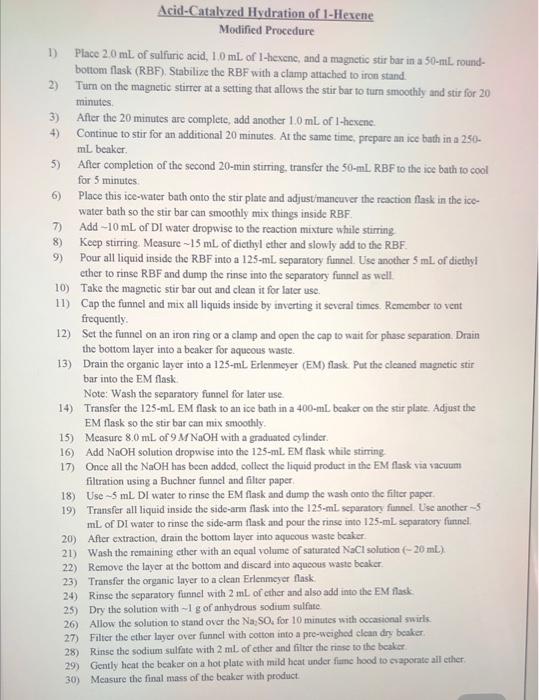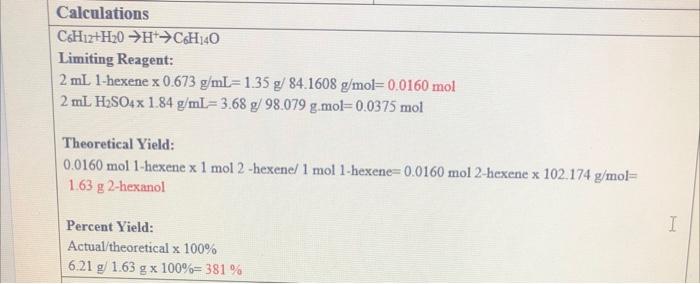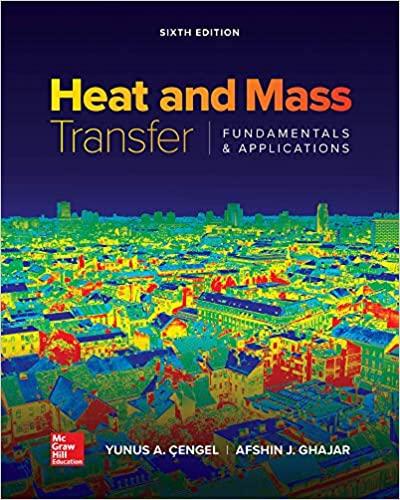Answered step by step
Verified Expert Solution
Question
1 Approved Answer
Can i get gelp answering questions 1 and 2 on percent yield and explaining the procedure. The product 2-hexanol resulted in a solid instead of
Can i get gelp answering questions 1 and 2 on percent yield and explaining the procedure. The product 2-hexanol resulted in a solid instead of a liquid, why did this happen? 


Acid-Catalyzed Hydration of 1-Hexene Modified Procedure 1) Place 2.0 mL of sulfuric acid, 1.0 ml. ofl-hexene, and a magnetic stir bar in a 50-ml.round- bottom flask (RBF). Stabilize the RBF with a clamp attached to iron stand. 2) Turn on the magnetic stirrer at a setting that allows the stir bar to turn smoothly and stir for 20 minutes 3) After the 20 minutes are complete, add another 1.0 mL of 1-hexene. 4) Continue to stir for an additional 20 minutes. At the same time, prepare an ice bath in a 250- ml beaker 5) After completion of the second 20-min stirring, transfer the 50-ml RBF to the ice bath to cool for 5 minutes 6) Place this ice-water bath onto the stir plate and adjust'maneuver the reaction flask in the ice- water bath so the stir bar can smoothly mix things inside RBF 7) Add-10 mL of Dl water dropwise to the reaction mixture while stirring 8) Keep stirring, Measure - 15 mL of dicthyl ether and slowly add to the RBF 9) Pour all liquid inside the RBF into a 125-m1. separatory funnel. Use another 5 mL of diethy! ether to rinse RBF and dump the rinse into the separatory funnel as well 10) Take the magnetic stir bar out and clean it for later use. 11) Cap the funnel and mix all liquids inside by inverting it several times. Remember to vent frequently 12) Set the funnel on an iron ring or a clamp and open the cap to wait for phase separation, Drain the bottom layer into a beaker for aqueous waste. 13) Drain the organic layer into a 125-ml Erlenmeyer (EM) flask. Put the cleaned magnetic stir bar into the EM flask Note: Wash the separatory funnel for later use. 14) Transfer the 125-ml EM flask to an ice bath in a 400-ml. beaker on the stir plate. Adjust the EM flask so the stir bar can mix smoothly. 15) Measure 8.0 mL of 9 M NaOH with a graduated cylinder 16) Add NaOH solution dropwise into the 125-ml. EM flask while stirring 17) Once all the NaOH has been added, collect the liquid product in the EM flask via vacuum filtration using a Buchner funnel and filter paper 18) Use-5 mL DI water to rinse the EM flask and dump the wash onto the filter paper 19) Transfer all liquid inside the side-arm flask into the 125 ml separatory funnel. Use another 5 mL of De water to rinse the side-arm flask and pour the rinse into 125-ml separatory funnel 20) After extraction, drain the bottom layer into aqueous waste beaker 21) Wash the remaining ether with an equal volume of saturated NaCl solution (-20 ml.). 22) Remove the layer at the bottom and discard into aqueous wasto boaker 23) Transfer the organic layer to a clean Erlenmeyer flask 24) Rinse the separatory funnel with 2 mL of ether and also add into the EM flask 25) Dry the solution with - 1 g of anhydrous sodium sulfate 26) Allow the solution to stand over the Na, So, for 10 minutes with occasional swirls 27) Filter the other layer over funnel with cotton into a pre-weighed clean dry baker 28) Rinse the sodium sulfate with 2 ml of cther and filter the rise to the beaker 29) Gently heat the beaker on a hot plate with mild heat under fime hood to csaporate all ether 30) Measure the final mass of the beaker with product Calculations CHz+H20 H+CH140 Limiting Reagent: 2 mL 1-hexene x 0.673 g/ml=1.35 g/84.1608 g/mol=0.0160 mol 2 mL H2SO4x 1.84 g/ml=3.68 g/98.079 g.mol=0.0375 mol Theoretical Yield: 0.0160 mol 1-hexene x 1 mol 2 -hexene/ 1 mol 1-hexene=0.0160 mol 2-hexene x 102.174 g/mol= 163 g 2-hexanol 1 Percent Yield: Actual/theoretical x 100% 6.21 g/ 1.63 g x 100%= 381 % 1. Percent yield and discussion (3 pts) Report percent yield. If it is larger than 100%, discuss the possible impurity and explain why it stays in the final product, if it is smaller than 100%, discuss the reasons and explain why 100% yield is not achieved Do not simply say calculation error or human error. You need to give more detailed and specific discussion 2. Explain procedure (2 pts) During vacuum filtration, product in the liquid is separated from a solid. Give a possible chemical formula of this solid. Explain why you think the solid is this compound. You can show chemical equations here to help your explanation 


Step by Step Solution
There are 3 Steps involved in it
Step: 1

Get Instant Access to Expert-Tailored Solutions
See step-by-step solutions with expert insights and AI powered tools for academic success
Step: 2

Step: 3

Ace Your Homework with AI
Get the answers you need in no time with our AI-driven, step-by-step assistance
Get Started


